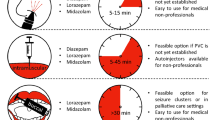Abstract
Aim
Our goal was to investigate the use of hypnosedatives (HSs) before and during hospitalization, explore the relationship between their use and various demographic and clinical variables, and compare the results with data from a similar 2000 study with particular interest in adherence to hospital formulary guidelines.
Methods
A cross-sectional observational survey of 326 hospitalized patients recruited from ten wards of the Ghent University Hospital, Gent, Belgium, with a patient interview and by evaluating medical and nursing files.
Results
In 30.7% of patients, the use of a HS before admission was reported. According to the patient interview, 33.1% used a HS during hospitalization. However, according to medical and nursing files, use of HSs in the hospital was 10% higher (43.3%). In 19.4% of patients who took HSs before admission, their use was discontinued in the hospital. In 15.6% of patients who took no HS before admission, a HS was started in the hospital, according to the formulary guidelines (data from files). There was a positive correlation between HS use in the hospital and older age, longer hospitalization, not coming from home, higher number of HSs taken before hospitalization, sleeping problems emerging during hospitalization, and central nervous system (CNS) disorders. In comparison with 2000, we registered a slight decrease in HS use during hospitalization and a decrease in the number of newly started patients.
Conclusions
The prevalence of HS use in our university hospital is high, mostly as a result of continuation of HSs started before admission, as there seems to be no general policy of active cessation. Compared with the survey performed 10 years ago, fewer hospitalized patients are newly started on HSs, and when this is the case, the formulary guidelines are followed.
Similar content being viewed by others
References
Buscemi N, Vandermeer B, Friesen C, Bialy L, Tubman M, Ospina M, Klassen TP, Witmans M (2007) The efficacy and safety of drug treatments for chronic insomnia in adults: a meta-analysis of RCTs. J Gen Intern Med 22:1335–1350
Panneman MJ, Goettsch WG, Kramarz P, Herings RM (2003) The costs of benzodiazepine-associated hospital-treated fall injuries in the EU: a Pharmo study. Drugs Aging 20:833–839
Holbrook AM, Crowther R, Lotter A, Cheng C, King D (2000) The diagnosis and management of insomnia in clinical practice: a practical evidence-based approach. CMAJ 162:216–220
Tamblyn R, Abrahamowicz M, du Berger R, McLeod P, Bartlett G (2005) A 5-year prospective assessment of the risk associated with individual benzodiazepines and doses in new elderly users. J Am Geriatr Soc 53:233–241
Petrovic M, Mariman A, Warie H, Afschrift M, Pevernagie D (2003) Is there a rationale for prescription of benzodiazepines in the elderly? Review of the literature. Acta Clin Belg 58:27–36
Glass J, Lanctot KL, Herrmann N, Sproule BA, Busto UE (2005) Sedative hypnotics in older people with insomnia: meta-analysis of risks and benefits. BMJ 331:1169
Pelissolo A, Notides C, Lepine JP, Bisserbe JC (1999) Anxiolytic and hypnotic use by general hospital inpatients. The impact of psychopathology and general medical conditions. Gen Hosp Psychiatry 21:79–86
Wancata J, Benda N, Lesch O, Muller C (1998) Use of anxiolytics and hypnotics in gynecological, surgical and medical departments of general hospitals. Pharmacopsychiatry 31:178–186
Bell CM, Fischer HD, Gill SS, Zagorski B, Sykora K, Wodchis WP, Herrmann N, Bronskill SE, Lee PE, Anderson GM, Rochon PA (2007) Initiation of benzodiazepines in the elderly after hospitalization. J Gen Intern Med 22:1024–1029
Stuffken R, van Hulten RP, Heerdink ER, Movig KL, Egberts AC (2005) The impact of hospitalisation on the initiation and long-term use of benzodiazepines. Eur J Clin Pharmacol 61:291–295
Belgian health surveys conducted in 1997, 2001 and 2004; www.iph.fgov.be/epidemio/epinl/crospnl/hisnl/his04nl/hisnl.pdf. 2010
Warie H, Petrovic M, Somers A, Mariman A, Robays H, Pevernagie D (2003) The use of hypnosedative drugs in a university hospital setting. Acta Clin Belg 58:225–232
Howes JB, Ryan J, Fairbrother G, O'Neill K, Howes LG (1996) Benzodiazepine prescribing in a Sydney teaching hospital. Med J Aust 165:305–308
Nakao M, Takeuchi T, Yano E (2007) Prescription of benzodiazepines and antidepressants to outpatients attending a Japanese university hospital. Int J Clin Pharmacol Ther 45:30–35
Edwards C, Bushnell JL, Ashton CH, Rawlins MD (1991) Hospital prescribing and usage of hypnotics and anxiolytics. Br J Clin Pharmacol 31:190–192
O'Reilly R, Rusnak C (1990) The use of sedative-hypnotic drugs in a university teaching hospital. CMAJ 142:585–589
Halfens RJ, Lendfers ML, Cox K (1991) Sleep medication in Dutch hospitals. J Adv Nurs 16:1422–1427
Saltvedt I, Spigset O, Ruths S, Fayers P, Kaasa S, Sletvold O (2005) Patterns of drug prescription in a geriatric evaluation and management unit as compared with the general medical wards: a randomised study. Eur J Clin Pharmacol 61:921–928
Agostini JV, Concato J, Inouye SK (2008) Improving sedative-hypnotic prescribing in older hospitalized patients: provider-perceived benefits and barriers of a computer-based reminder. J Gen Intern Med 23(Suppl 1):32–36
Petrovic M, Pevernagie D, Mariman A, Van Maele G, Afscrift M (2002) Fast withdrawal from benzodiazepines in geriatric inpatients: a randomised double-blind, placebo-controlled trial. Eur J Clin Pharmacol 57:759–764
Elliott RA, Woodward MC, Oborne CA (2001) Improving benzodiazepine prescribing for elderly hospital inpatients using audit and multidisciplinary feedback. Intern Med J 31:529–535
Acknowledgements
The authors are indebted to pharmacist F. Lavreau for her valuable help with data collection, to the participating heads of the medical departments, the head nurses, and to the participating patients. This study was not funded, and the authors have no conflicts of interest.
Author information
Authors and Affiliations
Corresponding author
Rights and permissions
About this article
Cite this article
Somers, A., Robays, H., Audenaert, K. et al. The use of hypnosedative drugs in a university hospital: has anything changed in 10 years?. Eur J Clin Pharmacol 67, 723–729 (2011). https://doi.org/10.1007/s00228-010-0983-2
Received:
Accepted:
Published:
Issue Date:
DOI: https://doi.org/10.1007/s00228-010-0983-2




